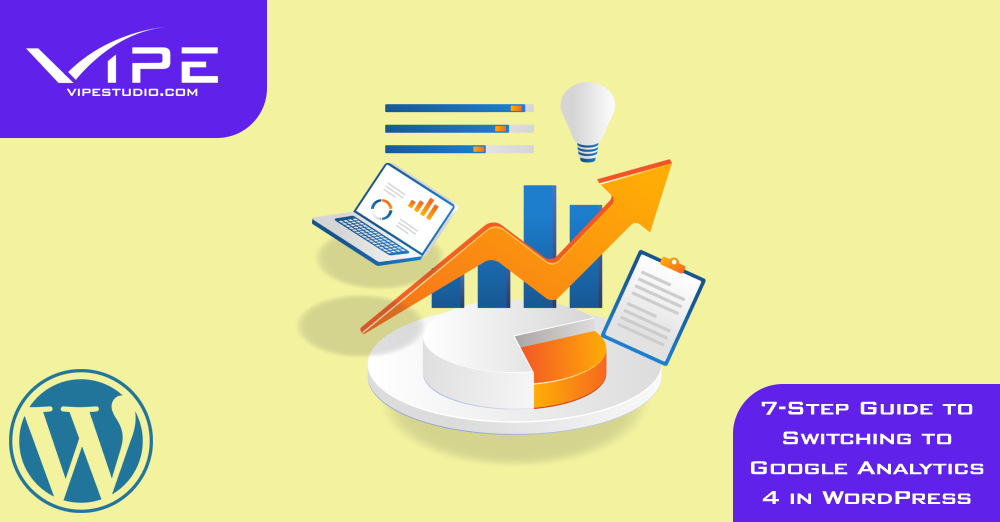08.08.2022
WordPress Marketing
7-Step Guide to Switching to Google Analytics 4 in WordPress
READING TIME: MIN
Table of Content
Google Analytics 4, often known as GA4, was published on October 14th, 2020. Google is describing this as their next-generation analytics system. Previously, it could have been called Apps> Web Properties in your Google Analytics account.
Our WordPress development agency reminds you that it’s crucial to understand the value of analytics on your WordPress website before integrating this new Google Analytics. You may gain insight into a variety of statistics that can be applied to marketing, engagement, SEO, social media, and more using analytical data and traffic figures coming from your website. Activate GA4 in WordPress.

1. Go to Your Google Analytics Account
Go to the Google Analytics home page and log in using your Google account to begin the process. Your dashboard will now be accessible, and we can continue from there.
2. Make a New Property in Google Analytics 4
You need to establish a new GA4 property right away as you are already on your Analytics dashboard. You have two options when setting up your new property: click on Admin > Create Account or choose an existing account. This guide will proceed by clicking “Create Property” on an existing account as it is assumed that you already have a Google Analytics account.

3. Complete the Property Details
You may access the Property Details page by selecting the “Create Property” option. You can enter all the necessary property details here. Add your property’s name, the time zone it is in, and any other necessary information. You decide how to put things up. Press the “Next” option when you are done to continue. This brings you to a few other details you might wish to provide. This covers the number of questions and the size of the business. You are free to complete this whatever you choose. Click the “Create” button at the bottom of the page when you are finished.
4. Pick the “Web” option
You will now be on the page for “Data Streams.” As you can see, there are three possibilities available. Web, iOS, and Android applications. Choose “Web”.
5. Configure Web Stream
A page that lets you configure your online broadcast appears when you select the Web option. Fill out every piece of the necessary information so that the stream may be created. You may do this by including your URL, naming your stream, and adding or removing any additional measurements you like. When you’re done, press the “Create Stream” button.

6. Link Your Current Analytics Asset to GA4
By selecting your UA Property from the drop-down menu after pressing the Admin button, return to your previous UA property. Select “Tracking” code from the dropdown menu after clicking the “Tracking Info” option. Copy your tracking code from the screen that appears so you have it. Select the new GA4 Property from the drop-down to return to your new GA4 Property. Next, choose the stream you just established and search for “Connected Site Tags.” Just click it. Give it a name, enter or paste the tracking ID you copied earlier, and then choose “Connect”.
7. Run Tracking Code on Your WordPress Website
You have finally reached the end of the procedure. To begin getting all the data and analytics that come with Google Analytics 4, you must first install the tracking code on your WordPress website. Select Global Tag when you choose “Add new on-page Tag” from your web stream (gtag.js). Take note of the tracking code. Let’s now add the code to your website.
Can I Use a Plugin to Add GA4?
The quick response is yes! There are several Google Analytics plugins that are now available, and many of them let you add Google Analytics 4 tracking features. Having said that, I suggest utilizing a Google Analytics plugin to do this.

Our WordPress development agency hopes this article will help you make the switch to Google Analytics smoother. For more WordPress tips and tricks keep reading our blog!
More on The Topic
- WordPress for High Traffic Sites: Strategies for Scalability and Stability
- Looking For the Best Email Marketing Strategy? Here Are 5 Tips for WordPress Websites
- Reaching New Heights in WordPress’s Conversion Rate: Sharing Must-Follow Tips
- 7 Must-Have Email Marketing Strategies for Your WordPress Website
- Content Strategy in WordPress: Yet Another Successful Business Guide
Tags: analyticsGAGA4google analyticsGoogle ANalytics 4WordPresswordpress website
The content of this website is copyrighted and protected by Creative Commons 4.0.



